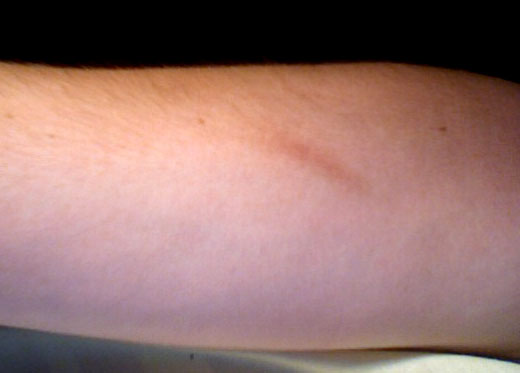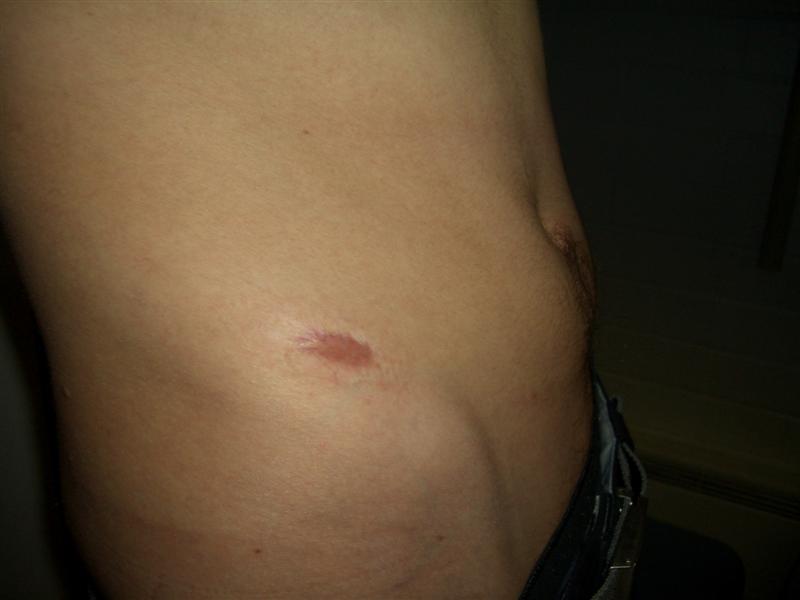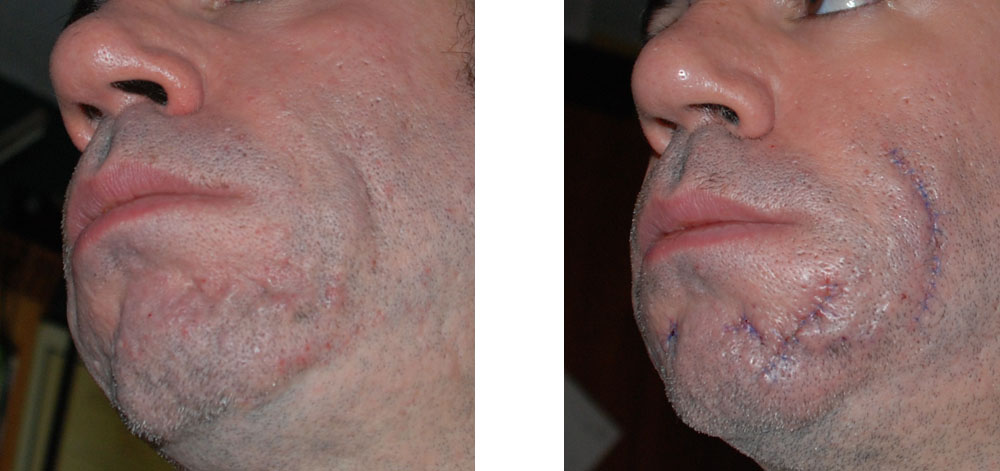Scar
|
WikiDoc Resources for Scar |
|
Articles |
|---|
|
Media |
|
Evidence Based Medicine |
|
Clinical Trials |
|
Ongoing Trials on Scar at Clinical Trials.gov Clinical Trials on Scar at Google
|
|
Guidelines / Policies / Govt |
|
US National Guidelines Clearinghouse on Scar
|
|
Books |
|
News |
|
Commentary |
|
Definitions |
|
Patient Resources / Community |
|
Directions to Hospitals Treating Scar Risk calculators and risk factors for Scar
|
|
Healthcare Provider Resources |
|
Continuing Medical Education (CME) |
|
International |
|
|
|
Business |
|
Experimental / Informatics |
Editor-In-Chief: C. Michael Gibson, M.S., M.D. [1]
Overview
Scars are areas of fibrous tissue that replace normal skin (or other tissue) after injury. A scar results from the biologic process of wound repair in the skin and other tissues of the body. Thus, scarring is a natural part of the healing process. With the exception of very minor lesions, every wound (e.g. after accident, disease, or surgery) results in some degree of scarring.
Scar tissue is not identical to the tissue which it replaces and is usually of inferior functional quality. For example, scars in the skin are less resistant to ultraviolet radiation, and sweat glands and hair follicles do not grow back within scar tissue. A myocardial infarction, commonly known as a heart attack, causes scar formation in the heart muscle which leads to loss of muscular power and possibly heart failure. However, there are some tissues (e.g. bone) which can heal without any structural or functional deterioration, and in fact bone tissue may be structurally stronger after a break.

The word scar was derived from the Greek word eschara, meaning place of fire (fireplace).
How scarring occurs
A scar is a natural part of the healing process. Skin scars occur when the deep, thick layer of skin (the dermis) is damaged. The worse the damage is, the worse the scar will be.
Most skin scars are flat, pale and leave a trace of the original injury which caused them. The redness that often follows an injury to the skin is not a scar, and is generally not permanent. The time it takes for it to go away may, however, range from a few days to, in some serious and rare cases, several years. Various treatments can speed up the process in serious cases.
Scars form differently based on the location of the injury on the body and the age of the person who was injured.
To mend the damage, the body has to lay down new collagen fibres (a naturally occurring protein which is produced by the body).
This process results in a fortuna scar. Because the body cannot re-build the tissue exactly as it was, the new scar tissue will have a different texture and quality than the surrounding normal tissue. An injury does not become a scar until the wound has completely healed.
Transforming Growth Factors (TGF) play a critical role in scar development and current research is investigating the manipulation of these TGFs for drug development to prevent scarring from the emergency (and rather inappropriate) adult wound healing process.
Abnormal scars
Two types of scars are the result of the body overproducing collagen, which causes the scar to be raised above the surrounding skin. Hypertrophic scars take the form of a red raised lump on the skin, but do not grow beyond the boundaries of the original wound, and they often improve in appearance after a few years. Keloid scars are a more serious form of scarring, because they can carry on growing indefinitely into a large, tumorous (although benign) growth.

Both hypertrophic and keloid scars are more common on younger and darker-skinned people. They can occur on anyone, but some people have a genetic susceptibility to these types of scarring. They can be caused by surgery, an accident, or sometimes by acne. Keloid scars can also develop from body piercings. In some people, keloid scars form spontaneously.
Although they can be a cosmetic problem, keloid scars are only inert masses of collagen and therefore completely harmless, painless, and non-contagious. They tend to be most common on the shoulders and chest. Keloid scars are most common among people of Asian or African descent.
Alternately, a scar can take the form of a sunken recess in the skin, which has a pitted appearance. These are caused when underlying structures supporting the skin, such as fat or muscle, are lost. This type of scarring is commonly associated with acne, but can be caused by chickenpox, surgery or an accident.
Scars can also take the form of stretched skin. These are caused when the skin is stretched rapidly (for instance during pregnancy, significant weight gain or adolescent growth spurts), or when skin is put under tension during the healing process, (usually near joints). This type of scar usually improves in appearance after a few years.
Treatments for skin scars
No scar can ever be completely removed. They will always leave a trace, but their appearance can be improved by a number of means, including:
Surgery
Scars, such as acne scars, can be cut out and stitched up, a process called scar revision.

Laser surgery & resurfacing
The use of lasers on scars is experimental treatment, the safety or effectiveness of which has not yet been proven.
The redness of scars may be reduced by treatment with a vascular laser. It has been theorized that removing layers of skin with a carbon dioxide laser may help flatten scars, although this treatment is still highly experimental.
The Fraxel laser was recently FDA approved for the treatment of acne scars.
Steroid injections
A long term course of steroid injections under medical supervision, into the scar may help flatten and soften the appearance of keloid or hypertrophic scars.
The steroid is injected into the scar itself; since very little is absorbed into the blood stream, side effects of this treatment are minor. This treatment is repeated at 4-6 week intervals.
Pressure garments
Pressure garments should be used only under supervision by a medical professional. They are most often used for burn scars that cover a large area, this treatment is only effective on recent scars.
Pressure garments are usually custom-made from elastic materials, and fit tightly around the scarring. They work best when they are worn 24 hours a day for six to twelve months.
It is believed that they work by applying constant pressure to surface blood vessels and eventually causing scars to flatten and become softer.
Radiotherapy
Low-dose, superficial radiotherapy, is used to prevent re-occurrence of severe keloid and hypertrophic scarring. It is usually effective, but only used in extreme cases due to the risk of long-term side effects.
Dermabrasion
Dermabrasion involves the removal of the surface of the skin with specialist equipment and usually involves a general anaesthetic. It is useful with raised scars, but is less effective when the scar is sunken below the surrounding skin.
Collagen injections
Collagen injections can be used to raise sunken scars to the level of surrounding skin. Its effects are however temporary, and it needs to be regularly repeated. There is also a risk in some people of an allergic reaction.
Other treatments
There are also a number of gel sheets available which are usually made from silicone, which can help to flatten and soften raised scars if worn regularly. Silicone, pressure, occlusion, topical cortisone and vitamin E have all been shown to decrease the collagen that forms scars. Patches and pads help but are unsightly so people tend to quit. Chemical peels performed by a dermatologist using glycolic acid can be used to minimize acne scarring.
Intentional scarring
The permanence of scarring has led to its intentional use as a form of body art within some cultures and subcultures (see scarification). Evidence of ritual scarring practices can be found in many tribes and cultures worldwide.
See also
External links
- WebMD.com article
- American Academy of Dermatology: "What is a scar?"
- Ohio State University Medical Center article
- American Society of Plastic Surgeons: Radiation Therapy for Keloid and Hypertrophic Scar
- Japan Scar Workshop
da:Ar (sår) de:Narbe (Wundheilung) it:Cicatrice he:צלקת la:Cicatrix nl:Litteken (huid) no:Arr nn:Arr simple:Scar fi:Arpikudos sv:Ärr